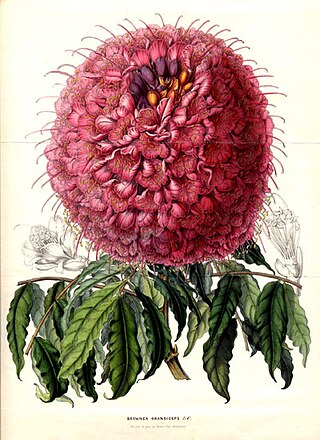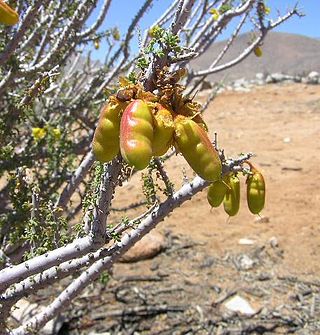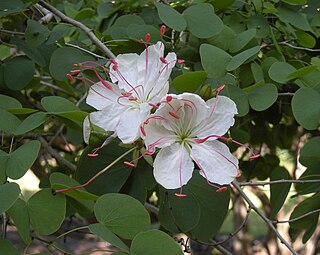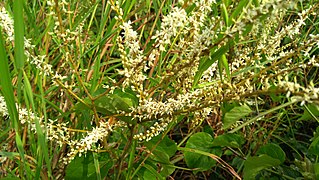
Bauhinia is a large genus of flowering plants in the subfamily Cercidoideae and tribe Bauhinieae, in the large flowering plant family Fabaceae, with a pantropical distribution. The genus was named after the Bauhin brothers Gaspard and Johann, Swiss-French botanists.

Cassia is a genus of flowering plants in the legume family, Fabaceae, and the subfamily Caesalpinioideae. Species are known commonly as cassias. The genus includes 37 species and has a pantropical distribution. Species of the genera Senna and Chamaecrista were previously included in Cassia. Cassia now generally includes the largest species of the legume subtribe Cassiinae, usually mid-sized to tall trees.

The plant tribe Phaseoleae is one of the subdivisions of the legume subfamily Faboideae, in the unranked NPAAA clade. This group includes many of the beans cultivated for human and animal food, most importantly from the genera Glycine, Phaseolus, and Vigna.

Camoensia is a genus of 2 species of lianas in the family Fabaceae, subfamily Faboideae, native to the Gulf of Guinea, Africa. C. scandens is cultivated as an ornamental plant; it has one of the largest leguminous flowers, up to 20 cm across. The genus has classically been assigned to the tribe Sophoreae, but was recently assigned to its own monophyletic tribe, Camoensieae, on the basis of molecular phylogenetic evidence. Species of Camoensia are known to produce quinolizidine alkaloids, consistent with their placement in the genistoid clade.

The subfamily Detarioideae is one of the subdivisions of the plant family Fabaceae (legumes). This subfamily includes many tropical trees, some of which are used for timber or have ecological importance. The subfamily consists of 84 genera, most of which are native to Africa and Asia. Pride of Burma and tamarind are two of the most notable species in Detarioideae. It has the following clade-based definition:
The most inclusive crown clade containing Goniorrhachis marginataTaub. and Aphanocalyx cynometroidesOliv., but not Cercis canadensisL., Duparquetia orchidaceaBaill., or Bobgunnia fistuloides(Harms) J. H. Kirkbr. & Wiersema.

The genus Tylosema is in the plant family Fabaceae and encompasses four accepted species of perennial legumes native to southern and central Africa. These are semi-woody viniferous plants broadly distributed from Sudan and Ethiopia south to Angola and South Africa. Coetzer and Ross originally described four Tylosema species:

Gigasiphon is a genus of plants in the family Fabaceae. The genus is circumscribed is defined by "a long-tubular hypanthium, an arborescent habit, and a calyx divided into two lobes." It includes five species native to eastern Africa, Madagascar, the Philippines, New Guinea, and Lesser Sunda Islands.

Cercidoideae is a subfamily in the pea family, Fabaceae. Well-known members include Cercis (redbuds), including species widely cultivated as ornamental trees in the United States and Europe, Bauhinia, widely cultivated as an ornamental tree in tropical Asia, and Tylosema, a semi-woody genus of Africa. The subfamily occupies a basal position within the Fabaceae and is supported as monophyletic in many molecular phylogenies. At the 6th International Legume Conference, the Legume Phylogeny Working Group proposed elevating the tribe Cercidae to the level of subfamily within the Leguminosae (Fabaceae). The consensus agreed to the change, which was fully implemented in 2017. It has the following clade-based definition:
The most inclusive crown clade containing Cercis canadensisL. and Bauhinia divaricataL. but not Poeppigia proceraC.Presl, Duparquetia orchidaceaBaill., or Bobgunnia fistuloides(Harms) J.H.Kirkbr. & Wiersema.

Balsamocarpon brevifolium, or algarrobilla, is a species of flowering plants in the legume family, Fabaceae. It is the sole species in genus Balsamocarpon. Balsamocarpon belongs to the subfamily Caesalpinioideae and tribe Caesalpinieae. It is endemic to northern and north-central Chile.

The genus, Pterolobium, consists of 10 species of perennial flowering plants in the family Fabaceae, subfamily Caesalpinioideae and tribe Caesalpinieae. They are sometimes called redwings and are native to the tropical to subtropical climes of Africa and Asia, including Indonesia and the Philippines. They are large scrambling or climbing shrubs that grow in riverside thickets, on rocky slopes or at forest margins. They bear colourful samara fruit, and have pairs of thorns below the rachis of their bipinnate leaves.

Lysiphyllum is a genus of flowering plants in the legume family, Fabaceae. It includes nine species of trees, semi-scandent shrubs, and lianas which range from India through Southeast Asia to Australasia. Typical habitats include seasonally-dry tropical forest and woodland, vine thickets, Brigalow and Gidgee scrubland, floodplains, alluvial flats, tidal forest, mangroves, river and stream banks, and occasionally dunes and coral islets. They can grow on diverse soils including calcareous, granitic, and basaltic.

Phanera is a genus of flowering plants in the legume subfamily Cercidoideae and the tribe Bauhinieae. This genus differs from Bauhinia in being vines or lianas, generally with tendrils and a lobed rather than spathaceous calyx, and from Schnella in having only three fertile stamens rather than ten, and being native to the Indomalayan realm and the Australasian realm rather than the Americas. The subsection Corymbosae was recently segregated into a new genus, Cheniella. It has been suggested that the genus Lasiobema should be reduced to a section within Phanera.

Schnella is a genus of flowering plants in the legume family, Fabaceae. It belongs to the subfamily Cercidoideae. All of its species are neotropical lianas.

Mezoneuron is a genus of flowering plants in the legume family, Fabaceae. It belongs to the subfamily Caesalpinioideae and the tribe Caesalpinieae.
Phanera curtisii is a species of 'monkey ladder' lianas in the subfamily Cercidoideae and the tribe Bauhinieae, the genus having been separated from Bauhinia and the defunct genus Lasiobema. Under its synonym Bauhinia curtisii, records exist from Indochina and Malesia;.

Phanera scandens is a species of 'monkey ladder' lianas in the subfamily Cercidoideae and the tribe Bauhinieae, the genus having been separated from Bauhinia and the discontinued genus Lasiobema. Under its synonym, Bauhinia scandens, records exist from the Indian subcontinent, Indo-China and Malesia. Under the name Bauhinia scandens var. horsfieldii its Vietnamese name is móng bò leo.
Phanera cardinalis is a species of lianas in the subfamily Cercidoideae and the tribe Bauhinieae, the genus having been separated from Bauhinia and also placed in the defunct genus Lasiobema. Under its synonym, Bauhinia cardinalis, records exist from Vietnam, where it is called móng bò đỏ, mấu hang or mấu tràm; no subspecies were listed in the Catalogue of Life.

Cheniella is a genus of flowering plants in the legume family, Fabaceae. It belongs to the subfamily Cercidoideae and tribe Bauhinieae. It includes ten species which range from the eastern Himalayas through Indochina and China to Taiwan, Peninsular Malaysia, Sumatra, and Java. This genus differs from Phanera in having a hypanthium that is equal in length or longer than the sepals, indehiscent fruit, many-seeded fruit, and the funicle extending most of the circumference of the seed.
Phanera saigonensis is a species of lianas in the subfamily Cercidoideae and the tribe Bauhinieae, the genus having been separated from Bauhinia. Under its synonym Bauhinia saïgonensis, records exist from the tropical forests Indochina only.
Phanera ornata is a species of lianas in the subfamily Cercidoideae and the tribe Bauhinieae, the genus having been separated from Bauhinia. Under its synonym, Bauhinia ornata, its Vietnamese name is "móng bò diện". Distribution records exist from Assam, S. China and Indochina, where wild plants grow primarily in the tropical forest biome.















